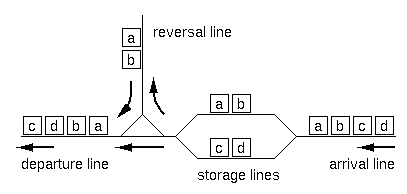POJ 3007 - Organize Your Train part II
来源:互联网 发布:基于比较排序算法 编辑:程序博客网 时间:2024/05/17 08:31
Description
RJ Freight, a Japanese railroad company for freight operations has recently constructed exchange lines at Hazawa, Yokohama. The layout of the lines is shown in Figure 1.

Figure 1: Layout of the exchange lines
A freight train consists of 2 to 72 freight cars. There are 26 types of freight cars, which are denoted by 26 lowercase letters from "a" to "z". The cars of the same type are indistinguishable from each other, and each car's direction doesn't matter either. Thus, a string of lowercase letters of length 2 to 72 is sufficient to completely express the configuration of a train.
Upon arrival at the exchange lines, a train is divided into two sub-trains at an arbitrary position (prior to entering the storage lines). Each of the sub-trains may have its direction reversed (using the reversal line). Finally, the two sub-trains are connected in either order to form the final configuration. Note that the reversal operation is optional for each of the sub-trains.
For example, if the arrival configuration is "abcd", the train is split into two sub-trains of either 3:1, 2:2 or 1:3 cars. For each of the splitting, possible final configurations are as follows ("+" indicates final concatenation position):
[3:1] abc+d cba+d d+abc d+cba [2:2] ab+cd ab+dc ba+cd ba+dc cd+ab cd+ba dc+ab dc+ba [1:3] a+bcd a+dcb bcd+a dcb+a
Excluding duplicates, 12 distinct configurations are possible.
Given an arrival configuration, answer the number of distinct configurations which can be constructed using the exchange lines described above.
Input
The entire input looks like the following.
the number of datasets = m
1st dataset
2nd dataset
...
m-th dataset
Each dataset represents an arriving train, and is a string of 2 to 72 lowercase letters in an input line.
Output
For each dataset, output the number of possible train configurations in a line. No other characters should appear in the output.
Sample Input
4aaabbaabcdabcde
Sample Output
161218
Source

#include <cstdio>#include <cstring>using namespace std;struct node{ int flag,next[26];} p[100086];int ans,top;void create(int x){ p[x].flag=0; for (int i=0; i<26; i++) p[x].next[i]=-1;}void add(int x,char *s,int l){ for (int i=0; i<l; i++) { if (p[x].next[s[i]-'a']<0) { p[x].next[s[i]-'a']=top; create(top++); } x=p[x].next[s[i]-'a']; } if (!p[x].flag) { p[x].flag=1; ans++; }}int main(){ int t,l,i,j,k,q; char s[128],s1[128],s2[128]; scanf("%d",&t); while(t--) { top=ans=0; create(top++); scanf("%s",s); l=(int)strlen(s); for (i=0; i<l; i++) { k=q=0; for (j=0; j<i; j++) s1[k++]=s[j]; for (j=i; j<l; j++) s2[q++]=s[j]; s1[k++]=s2[q++]=0; strcat(s2,s1); add(0,s2,(int)strlen(s2)); k=q=0; for (j=i-1; j>=0; j--) s1[k++]=s[j]; for (j=i; j<l; j++) s2[q++]=s[j]; s1[k++]=s2[q++]=0; strcat(s1,s2); add(0,s1,(int)strlen(s1)); k=q=0; for (j=i-1; j>=0; j--) s1[k++]=s[j]; for (j=i; j<l; j++) s2[q++]=s[j]; s1[k++]=s2[q++]=0; strcat(s2,s1); add(0,s2,(int)strlen(s2)); k=q=0; for (j=0; j<i; j++) s1[k++]=s[j]; for (j=l-1; j>=i; j--) s2[q++]=s[j]; s1[k++]=s2[q++]=0; strcat(s1,s2); add(0,s1,(int)strlen(s1)); k=q=0; for (j=0; j<i; j++) s1[k++]=s[j]; for (j=l-1; j>=i; j--) s2[q++]=s[j]; s1[k++]=s2[q++]=0; strcat(s2,s1); add(0,s2,(int)strlen(s2)); k=q=0; for (j=i-1; j>=0; j--) s1[k++]=s[j]; for (j=l-1; j>=i; j--) s2[q++]=s[j]; s1[k++]=s2[q++]=0; strcat(s1,s2); add(0,s1,(int)strlen(s1)); } printf("%d\n",ans); } return 0;}- POJ 3007 Organize Your Train part II
- POJ 3007 Organize Your Train part II
- POJ 3007 Organize Your Train part II
- POJ 3007:Organize Your Train part II
- poj-3007 Organize Your Train part II
- poj 3007 Organize Your Train part II
- POJ 3007 - Organize Your Train part II
- poj 3007Organize Your Train part II
- POJ Organize Your Train part II 3007
- poj-3007-Organize Your Train part II
- POJ 3007.Organize Your Train part II
- POJ 3007 Organize Your Train part II map+string
- POJ 3007 Organize Your Train part II(枚举)
- 【POJ 3007】 Organize Your Train part II (字符串HASH)
- Organize Your Train part II【POJ--3007】【平衡二叉树】
- [POJ 3007]Organize Your Train part II[Hash][Trie]
- POJ-3007 Organize Your Train part II (字符串hash)
- poj 3007 Organize Your Train part II 哈希判重
- 第四周项目3(1)-单链表应用 逆置单链表
- ZooKeeper系列之九:ZooKeeper API简介及编程
- 安卓Sqlite的使用
- Swift的学习(Closures(闭包))
- 【SDOI2009】bzoj1878 HH的项链【解法一】
- POJ 3007 - Organize Your Train part II
- 使用retainCount存在的问题
- CentOS卸载自带的Apache
- NGUI UIRoot的屏幕自适应
- Android点击View显示PopupWindow,再次重复点击View关闭PopupWindow
- ZooKeeper系列之十:ZooKeeper的一致性保证及Leader选举
- Data Binding Library数据绑定框架
- Android应用性能优化
- Struts2拦截器


